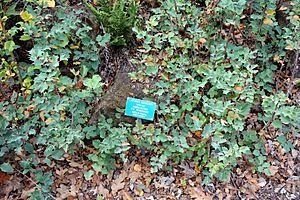Berberis dictyota facts for kids
Quick facts for kids Berberis dictyota |
|
|---|---|
 |
|
| Regional Parks Botanic Garden, Berkeley Hills. | |
| Scientific classification | |
| Genus: |
Berberis
|
| Species: |
dictyota
|
| Synonyms | |
|
|
Jepson's Oregon Grape, also known as shining netvein barberry, is a cool flowering plant. Its scientific name is Berberis dictyota. It belongs to the Barberry family. This plant was first described by a botanist named Willis Linn Jepson.
Where Does It Grow?
This special plant only grows naturally in California. When a plant or animal is found only in one specific place, we say it is endemic to that area.
You can find Jepson's Oregon Grape all over California! It grows from the southern Peninsular Ranges near San Diego all the way north to the Klamath Mountains in Siskiyou County. It also grows east into the Sierra Nevada mountains.
It likes to live in certain types of natural areas. These include chaparral (a type of shrubland), oak woodlands in the foothills, and yellow pine forests. You can find it growing at elevations from about 600 to 1800 meters (about 2,000 to 6,000 feet) above sea level.
What Does It Look Like?
Jepson's Oregon Grape is an evergreen shrub. This means it stays green all year long, even in winter. It can grow up to 2 meters (about 6.5 feet) tall.
Its leaves are very interesting. They are pinnate, which means they have smaller leaflets arranged along a central stem, like a feather. Each leaf usually has 5 to 7 leaflets. These leaflets are thick and stiff. Their undersides are whitish and covered with a thick, waxy layer. Each leaflet can be up to 9 centimeters (about 3.5 inches) long and has small spines along its edges.
In the spring, usually from February to April, the plant produces bright yellow flowers. These flowers grow in dense clusters called racemes. Each cluster can have up to 50 flowers, making the plant look very colorful!
After the flowers bloom, small berries appear. These berries are egg-shaped and have a dark blue color. Sometimes, they also have a waxy coating on them. The berries are small, usually up to 7 millimeters (about 0.3 inches) long.

